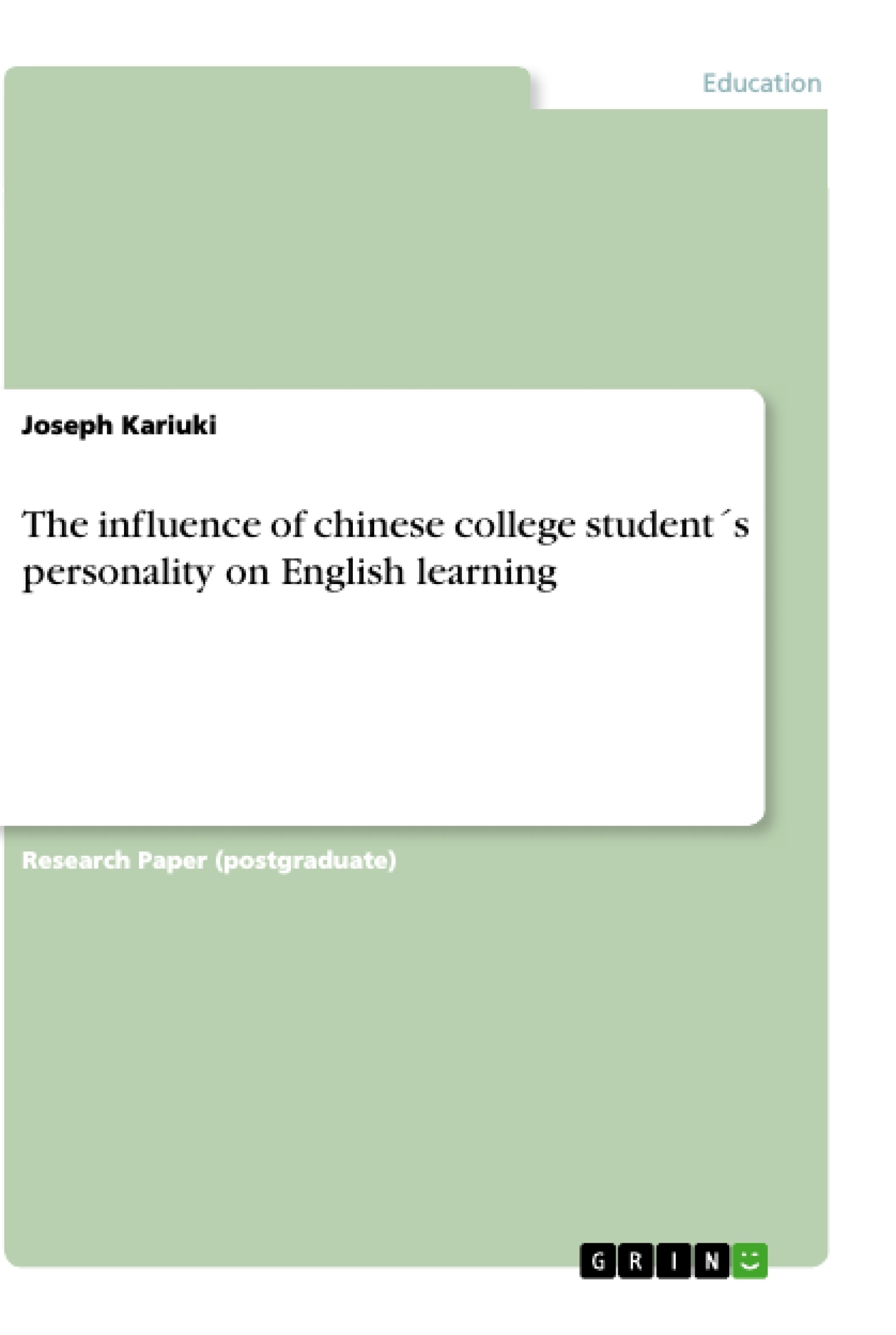The primary objective of this research was to gather data on personality differences which were affecting teachers teaching methods. The study was necessitated by having scenarios where Chinese’s students exhibited different learning styles due to the different personality traits. As a future teacher I felt the need to conduct this research and back up several studies that had been done on English learning as a foreign language. The study also checked and evaluated how personality differences affected learning and the personality effects in teachers teaching methods for Chinese college students. The study used qualitative study using literature review as methodology and described in-depth the conceptual philosophy, study strategy, data collecting procedure and techniques, strengths and limitations and ethical issues that were taken into consideration. There are different research philosophies that governed the study with qualitative research including ontology and epistemology. The research reported and discussed the cultural trends and the attitudes as well as approaches that Chinese college students had to their studies. The study also found out that Chinese college students used the major learning styles of rote, silent and passive. The study found that personality traits associated with students have a significant influence on the success of learning English as a second language.
Inhaltsverzeichnis (Table of Contents)
- Abstract
- 1.0 Introduction
- 1.1 Research Aims
- 1.2 Research Questions
- 1.4 Background and Context of the Study
- 1.5 Justification of the Study
- 1.6 Dissertation Outline
- 2. Research Design
- 2.1 Ontology
- 2.2 Epistemology
- 2.3 Methodological position
- 2.4 Data collection
- 2.5 Inclusion Criteria
- 2.6 Exclusion Criteria
- 2.7 Data Recording
- 2.7.1 Research Aims
- 2.7.2 Research Questions
- 2.8 Strengths and Limitations
- 2.8 Limitations
- 2.9 Research Ethics
- 3. Extended Literature Review
- 3.0 Introduction
- 3.1 History of Teaching English as a Foreign Language (EFL) in China
- 3.2 Learning Styles of Chinese College Students
- 3.2.1 Rote-Learning
- 3.2.2 Silent Learning
- 3.2.3 Passive Learning
- 3.3 Teaching English as Foreign Language in China (TEFL)
- 3.3.1 Qing Dynasty and TEFL
- 33.4 TEFL in Chinese Educational Institutions
- 3.5 Programs for Cultural Exchange in China
- 3.6 Teaching and Learning Styles
- 3.7 Differentiating between personality traits among Chinese students
- 3.7.1 Theoretical foundations of the study
- 3.7.2 Personality traits and English learning
- 3.7.3 Academic Performance and the Big Five personality characteristics
- 3.8 Theory of self-determination and motivation
- 3.8.1 Self Determination and English Learning
- 3.9 Self-regulation effectiveness from a socio-cognitive perspective
- 3.9.1 Educational motivation and self-regulation efficacy as mediators
- 3.10 Personality and accomplishment of the Foreign Language
- 3.11 Personalities and Global Competency
- 3.12 Research Ethics
- 3.13 Preventing Biasness in the Selection of Studies Used in the Literature Review
- 3.14 Teaching English As a Foreign Language
- 3.15 Discussion and Conclusion
- 4. Results and Discussion
- 4.1 Learning process and learning styles of Chinese students
- 4.2 Teaching English as Foreign Language in China
- 4.3 Personalities and English Learning
- 4.4 Self Determination and English Learning
- 4.5 Self-efficacy and English Learning
- 4.6 Global competency and English learning
- 4.7 Effects of Personalities on English Learning by Chinese Students
- 5. Conclusion
- References
Zielsetzung und Themenschwerpunkte (Objectives and Key Themes)
This research investigates the influence of personality differences on English language learning among Chinese college students. The study aims to identify how personality traits affect learning styles and teaching methods, ultimately seeking to understand the impact of personality on the success of English language acquisition.- The impact of personality on English language learning among Chinese students
- The relationship between personality traits and learning styles in Chinese students
- The influence of personality on teaching methods for English as a foreign language
- The role of self-determination and self-efficacy in English language learning
- The significance of global competency in the context of English language learning
Zusammenfassung der Kapitel (Chapter Summaries)
The introduction of the dissertation outlines the research aims and objectives, providing context and justification for the study. It explores the background of the research problem, highlighting the need to understand how personality differences influence English language learning among Chinese students. Chapter 2 delves into the research design, outlining the ontological and epistemological frameworks guiding the study. It discusses data collection methods, inclusion and exclusion criteria, data recording procedures, strengths and limitations, and ethical considerations. Chapter 3 presents an extended literature review, examining the history of teaching English as a foreign language in China, the learning styles of Chinese college students, and the relationship between personality traits and English language learning. It explores theoretical foundations such as the Big Five personality model and the theory of self-determination. Chapter 4 analyzes the findings of the study, focusing on the relationship between learning styles, teaching methods, personality traits, self-determination, self-efficacy, global competency, and English language acquisition among Chinese students.Schlüsselwörter (Keywords)
This research focuses on the intersection of personality, learning styles, and English language acquisition among Chinese college students. Key concepts include personality traits, learning styles, teaching methods, self-determination, self-efficacy, global competency, and the impact of these factors on the success of English language learning in China.- Citation du texte
- Joseph Kariuki (Auteur), The influence of chinese college student´s personality on English learning, Munich, GRIN Verlag, https://www.grin.com/document/1189886



